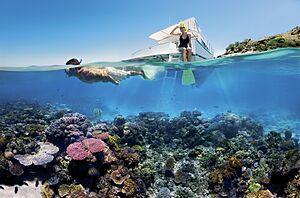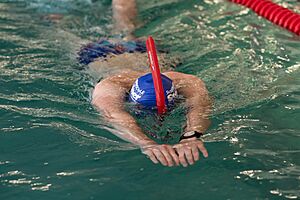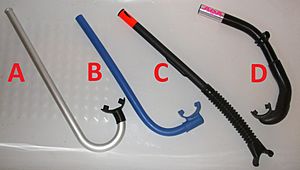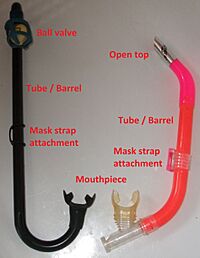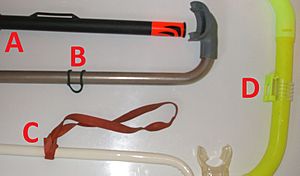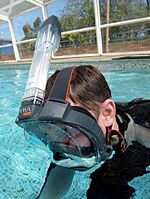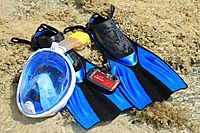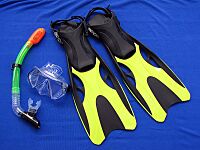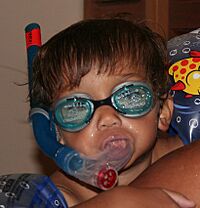Snorkel (swimming) facts for kids

Snorkel, worn with diving half mask
|
|
| Uses | Breathing while face down at the surface of the water |
|---|---|
| Related items | Diving mask, Swimming goggles |
A snorkel is a cool tool that helps you breathe air from above the water while your face is underwater. People often use a snorkel with a diving mask. This lets them float on the water's surface and look around without lifting their head to breathe.
Most snorkels are curved tubes. They often look like the letter "L" or "J." At the bottom, there's a special part called a mouthpiece. You hold this part in your mouth. Snorkels are usually made from plastic, synthetic rubber, or rubber. Some snorkels have a clip or loop. This helps you attach it to your diving mask strap. Other snorkels can just be tucked under the mask strap.
Some snorkels have special features. A float valve can stop water from getting in if your head goes too deep. Others have a water trap and a purge valve. These help drain any water that gets into the tube.
Sometimes, after using a snorkel for a long time, breathing can feel a bit hard. This is because some of the carbon dioxide (CO2) you breathe out can stay in the tube. You might breathe it back in. This can lead to a buildup of CO2 in your blood, which is called hypercapnia.
Contents
How a Snorkel Works
A snorkel lets you breathe fresh air while your face is underwater. This is great for swimming or floating on the surface. A good snorkel has a tube that is wide enough. This makes it easy for you to breathe in and out comfortably.
Snorkel tubes are made to be a certain length. If the tube were too long, breathing would be much harder. This is especially true if you are in deeper water. The water pressure around you would make your lungs work harder to expand.
Types of Snorkels
The most common snorkels are separate from your diving mask. They usually have an "L" or "J" shape. People call them "simple," "tube," or "independent snorkels." They have a curved tube and a mouthpiece you bite on. These tubes are open at the top. This means water can get in if the top goes underwater. Some snorkels have a valve at the top. This valve helps stop water from entering when the tube is submerged.
Some snorkels have a small "sump" at the lowest point. This sump collects any small amount of water. It stops you from breathing in this water when you take a breath.
"Integrated" snorkels are built right into a snorkel mask. These masks can be a half-mask. A half-mask covers only your eyes and nose. Or they can be a full-face mask. A full-face mask covers your eyes, nose, and mouth.
Using Your Snorkel
When you use a snorkel, you put the mouthpiece in your mouth. Make sure the top of the tube stays above the water. Then you can breathe freely. If the top of the tube goes underwater, water might get in. But don't worry, you can clear it out!
One way to clear water is called blast clearing. First, make sure the top of the tube is above water again. Then, breathe out sharply. This will shoot the water out of the tube. Another way is displacement clearing. This works when you come up from being underwater. Just before you reach the surface, tilt your head back. Breathe out until you are at the surface. Then, face down again before taking your next breath.
Snorkel Risks
For People
When you breathe, you take in oxygen and breathe out carbon dioxide (CO2). Because a snorkel is a tube, some of the CO2 you breathe out can stay inside it. You might breathe this CO2 back in with your next breath. This can increase the risk of hypercapnia. This is when too much carbon dioxide builds up in your blood. A narrower tube means less CO2 is left for your next breath. But it also makes it harder to breathe.
There is also a small risk if you are stressed or working very hard. Even if you can breathe easily in calm conditions, it might become harder. This could lead to hypercapnia and possibly panic.
For Materials
Modern snorkels use silicone rubber for the mouthpiece and valves. This material is great because it lasts a long time. Older snorkels used natural rubber. But natural rubber can break down over time. Sunlight's ultraviolet (UV) rays can make it lose its flexibility. It can become brittle and crack. This can cause valves or mouthpieces to leak. Also, some people can have an allergic reaction to natural rubber.
What Snorkels Are Used For
Snorkels are used in many water activities. These include snorkeling, finswimming, freediving, and scuba diving. When scuba diving, snorkels are not used underwater. But they are handy when a diver needs to swim on the surface for a long time. They help save the air in the scuba tank. Some scuba divers even carry a snorkel that can fold up. This keeps it out of the way when they are diving deep.
Snorkel History
People have thought about breathing underwater for a very long time. The ancient Greek thinker Aristotle wrote about it around 350 B.C. He mentioned divers using "instruments for respiration." He said they looked like an elephant's trunk. Some clues suggest that sponge divers used hollow reeds 5,000 years ago in Crete. In the 1400s, Leonardo da Vinci even drew designs for an underwater breathing device.
The first time a swimmer's breathing tube and mask were officially used was in 1927. Jacques O'Marchal showed them off in 1931. He also wore the first "flippers." These were designed by Louis de Corlieu. Throughout the 1930s, inventors worked to make snorkels better.
The word "snorkel" was first used in 1950 for a swimmer's breathing device. In 1969, Britain was the first country to make rules for snorkels. These rules set sizes for adult and child snorkels. They also said what materials and designs were allowed. Every snorkel had to have a warning label and instructions. Now, many other countries have rules about snorkel tube length and width.
Snorkel Shapes and How They Are Worn
Snorkels are made to be worn in two main ways: front-mounted and side-mounted. The very first patented snorkel in 1938 was front-mounted. It was worn over the front of the face. It attached to the diving mask with a bracket.
Side-mounted snorkels are usually worn by scuba divers. They are placed on the left side of the head. This is because the scuba regulator hose goes over the right shoulder. Side-mounted snorkels come in at least four basic shapes: J-shaped, L-shaped, flexible-hose, and contour. You can see what each looks like in the picture to the right.
- A. J-shaped
- B. L-shaped
- C. Flexible-hose
- D. Contour
How a Basic Snorkel Is Made
A basic, or independent, snorkel is a curved tube. It has a mouthpiece that you put between your lips and hold with your teeth.
The barrel is the hollow tube of the snorkel. It goes from the top down to the mouthpiece. The barrel is made of strong material like plastic, light metal, or hard rubber. The top of the barrel can be open. Or it might have a valve that closes when it goes underwater. Sometimes, there's a red or orange band at the top. This helps other swimmers see your snorkel.
There are different ways to attach a snorkel to you. The easiest way is to put the barrel between your mask strap and your head. Other ways are shown in the picture to the right:
- A. The mask strap goes through a loop built into the barrel.
- B. The mask strap goes through a separate rubber loop or plastic clip. This slides over the barrel and stays in place.
- C. A rubber band on this old 1950s snorkel stretches over your head above the mask.
- D. The mask strap goes through a plastic snorkel keeper. This keeper can turn and is about halfway up the barrel.
The mouthpiece is the part that keeps the snorkel in your mouth. It is made of soft, flexible material like PVC. The picture on the right shows different types of mouthpieces.
How Integrated Snorkels Are Made
Integrated snorkels have one or two tubes that are part of a swim or dive mask. They can be part of a half-mask or a full-face snorkel mask (FFSM). The picture to the right shows some integrated snorkels.
- A. This integrated snorkel is a half-mask. It covers only the eyes and nose. A single snorkel tube comes from the top of the mask. It has a ball float shut-off valve at the end.
- B. This is a full-face snorkel mask (FFSM). It covers your eyes, nose, and mouth. It has two snorkel tubes. They come from each side of the mask. They have "gamma" shut-off valves at the top.
- C. This model is also a half-mask. It covers only the eyes and nose. It has two removable snorkel tubes. They come from each side of the mask. They have ball float shut-off valves. This model also comes with plugs. You can use these plugs when the snorkels are not attached.
Other Snorkeling Gear
Seeing Underwater
If you use a separate snorkel, you will usually wear a diving half-mask or swimming goggles. These help you see better underwater vision. The mask creates an air space in front of your eyes. This lets you see clearly underwater.
Swimming Help
The most common swimming aids for snorkelers are swimfins. A snorkeling vest can also be used to help you float.
Staying Safe and Warm
Many snorkelers wear wetsuits or dry suits. These suits protect you from cold water. They also protect you from ultraviolet (UV) rays from the sun. A wetsuit is very popular for keeping swimmers and divers warm. Wetsuits, diving skins, and rash vests all offer UV protection. Some divers are also starting to use dry suits. These were common in the 1950s and 1960s. They are often used in lakes and rivers.
Cool Facts About Snorkels
- Aristotle is thought to have had the first idea for a snorkel. He wrote about an elephant using its trunk to breathe underwater around 350 B.C.
- The word “snorkel” comes from the German word “Schnorchel.” This means "snout."
- The first patented snorkel was front-mounted. It was worn over the face. But side-mounted snorkels became more popular in the late 1950s.
- Front-mounted snorkels have become popular again in competitive swimming. They are more streamlined than side-mounted snorkels.
- Some older snorkels had small balls in a cage at the top. These were meant to stop water from getting in. But they are not recommended anymore. They can be dangerous and are even illegal in some countries.
- Snorkels are not used during scuba diving unless the diver is swimming on the surface for a long time.
- Snorkels let you breathe with your face in the water. So, it's a good idea to look up occasionally. Make sure you are not swimming too far from shore or a boat.
- A snorkel can last from 2 to 15 years. This depends on how much it is used and how well you take care of it.
- Using a snorkel can be very relaxing. It lets you glide slowly along the water's surface.
|


